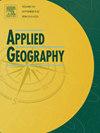Regional differences and driving factors of population security in China's border areas from the location perspective
IF 5.4
2区 地球科学
Q1 GEOGRAPHY
引用次数: 0
Abstract
Population security in border areas is the foundation and an important guarantee of national security. Research on its driving mechanisms can provide a reference for promoting sustainable development in border areas and formulating national border security policies. From a locational perspective, this paper divides China's border areas into five regions, constructs a theoretical framework for the connotation and driving factors of population security in border areas, and establishes an indicator system suitable for evaluating the level of population security in border areas. Using the Topsis-entropy method and the geographic detector model, this study analyzes regional differences in population security levels in border areas from 1990 to 2020 and their driving factors. The results show that from 1990 to 2020, the population security level in border areas first increased and then declined, with an overall low level. There are significant variations in population security development types across different border areas, with growth rates gradually slowing and regional disparities narrowing. The population security level in border areas is influenced by various factors and exhibits significant spatial heterogeneity. To promote the coordinated development of border areas and safeguard national security, this paper proposes specific policy recommendations addressing population security issues and their underlying causes.
区位视角下中国边境地区人口安全的区域差异与驱动因素
边境地区人口安全是国家安全的基础和重要保障。研究其驱动机制可为促进边境地区可持续发展和制定国家边境安全政策提供参考。本文从区位视角出发,将中国边境地区划分为五大区域,构建了边境地区人口安全内涵及其驱动因素的理论框架,建立了适合于边境地区人口安全水平评价的指标体系。利用topsis -熵法和地理探测器模型,分析了1990 - 2020年中国边境地区人口安全水平的区域差异及其驱动因素。结果表明:1990—2020年,边疆地区人口安全水平呈现先上升后下降的趋势,总体水平较低;不同边境地区人口安全发展类型差异显著,增速逐渐放缓,区域差距缩小。边境地区人口安全水平受多种因素影响,具有显著的空间异质性。为促进边境地区协调发展,维护国家安全,本文提出了解决人口安全问题及其根源的具体政策建议。
本文章由计算机程序翻译,如有差异,请以英文原文为准。
求助全文
约1分钟内获得全文
求助全文
来源期刊

Applied Geography
GEOGRAPHY-
CiteScore
8.00
自引率
2.00%
发文量
134
期刊介绍:
Applied Geography is a journal devoted to the publication of research which utilizes geographic approaches (human, physical, nature-society and GIScience) to resolve human problems that have a spatial dimension. These problems may be related to the assessment, management and allocation of the world physical and/or human resources. The underlying rationale of the journal is that only through a clear understanding of the relevant societal, physical, and coupled natural-humans systems can we resolve such problems. Papers are invited on any theme involving the application of geographical theory and methodology in the resolution of human problems.
 求助内容:
求助内容: 应助结果提醒方式:
应助结果提醒方式:


